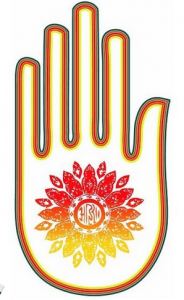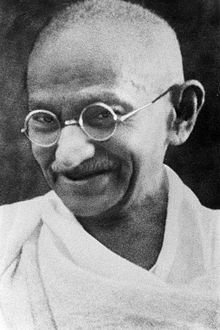Let me share a personal story with you. Last year I was on a Reiki practice , and during the practice I saw a beautiful symbol in my hand radiating to my palm. After getting home I was searching for the pic on the internet, and it turned out to be the AHIMSA symbol.
I was interested in it. I felt I know it from the collective consciousness and from my “cells in my body”.
Ahinsa (Sanskrit: अहिंसा; Pali: avihiṃsā) is a term meaning ‘not to injure’ and ‘to be compassionate’. The word is derived from the Sanskrit root hiṃs – to strike; hiṃsā is injury or harm, a-hiṃsā is the opposite of this, i.e. cause no injury, do no harm.Ahinsa is also referred to as nonviolence. and it applies to all living beings – including all animals – according to many Indian religions. Ahinsa is one of the cardinal virtues and an important tenet of 3 major religions (Jainism, Hinduism, Buddhism).
Ahinsa is a multidimensional concept, inspired by the premise that all living beings have the spark of the divine spiritual energy; therefore, to hurt another being is to hurt oneself. Ahinsa has also been related to the notion that any violence has karmic consequences. While ancient scholars of Hinduism pioneered and over time perfected the principles of Ahinsa, the concept reached an extraordinary status in the ethical philosophy of Jainism. Most popularly, Mahatma Gandhi strongly believed in the principle of ahinsa.
Ahinsa’s precept of ’cause no injury’ includes one’s deeds, words, and thoughts.Classical literature of Hinduism such as Mahabharata and Ramayana, as well as modern scholars debate principles of Ahinsa when one is faced with war and situations requiring self-defense.
Ancient texts use ahinsa to mean non-injury, a broader concept than non-violence. Non-injury implies not killing others, as well as not hurting others mentally or verbally; it includes avoiding all violent means – including physical violence – anything that injures others. In classical Sanskrit literature of Hinduism, another word Adrohi is sometimes used instead of Ahinsa, as one of the cardinal virtues necessary for moral life
Hinduism
Ancient Vedic Texts
Ahinsa as an ethical concept evolved in Vedic texts.The oldest scripts, along with discussing ritual animal sacrifices, indirectly mention Ahinsa, but do not emphasize it. Over time, the Hindu scripts revise ritual practices and the concept of Ahinsa is increasingly refined and emphasized, ultimately Ahinsa becomes the concept that describes the highest virtue by the late Vedic era (about 500 BC). For example, hymn 10.22.13 in the Rig Veda uses the words Satya (truthfulness) and Ahinsa in a prayer to deity Indra; later, the Yajur Veda dated to be between 1000 BC and 600 BC, states, “may all beings look at me with a friendly eye, may I do likewise, and may we look at each other with the eyes of a friend”.
The Epics
The Mahabharata, one of the epics of Hinduism, has multiple mentions of the phrase Ahinsa Paramo Dharma (अहिंसा परमॊ धर्मः), which literally means: non-violence is the highest moral virtue. For example:
अहिंसा परमॊ धर्मस तथाहिंसा परॊ दमः।
अहिंसा परमं दानम अहिंसा परमस तपः।
अहिंसा परमॊ यज्ञस तथाहिस्मा परं बलम।
अहिंसा परमं मित्रम अहिंसा परमं सुखम।
अहिंसा परमं सत्यम अहिंसा परमं शरुतम॥
The above passage from Mahabharata emphasizes the cardinal importance of Ahinsa in Hinduism, and literally means: Ahinsa is the highest virtue, Ahinsa is the highest self-control, Ahinsa is the greatest gift, Ahinsa is the best suffering, Ahinsa is the highest sacrifice, Ahinsa is the finest strength, Ahinsa is the greatest friend, Ahinsa is the greatest happiness, Ahinsa is the highest truth, and Ahinsa is the greatest teaching.
Modern times
In Gandhi’s thought, Ahinsa precludes not only the act of inflicting a physical injury, but also mental states like evil thoughts and hatred, unkind behavior such as harsh words, dishonesty and lying, all of which he saw as manifestations of violence incompatible with Ahinsa. Gandhi believed Ahinsa to be a creative energy force, encompassing all interactions leading one’s self to find satya, “Divine Truth”.





Kommentek
Kommenteléshez kérlek, jelentkezz be: